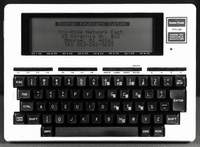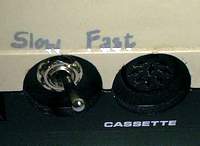ANTIQUE COMPUTER (13 january 2004)
One spring day (it must have been seven years ago) I visited a Dutch town called Hilversum, with my family.
An important attraction that almost any town or city has to offer is looking at shop windows. Like most other male chauvinst pigs, I'm not terribly much interested in shops for women's clothing or jewelry. But other shops, like those that specialize in hardware, old books or electronics, often have my undivided attention.
So when I saw an electronics shop in this rather drab town, you'll understand that I veered away from my family to have a look at the shop window.
But what I saw there made this shop window into one of the most memorable shop-windows in my life: my surprised eyes saw the oldest laptop computer ever invented: the TRS-80 model 100.
I had seen this computer in 1983, when it was too expensive for my limited means. But this one was offered at a price that would buy you a meal at a not too expensive Chinese restaurant.

If you read my earlier weblog about portable hardware, you may have your doubts about the portability of an antique laptop computer. But this machine was about the same size as a modern laptop pc. How was this possible?
Well ... it may have been the same size; it definitely did not have the same specifications, for instance:
- It had no floppy or hard disks;
- Its memory was no more than 48K RAM;
- Its screen had space for only 320 characters;
- Its screen was black & white;
- Its screen resolution was 64 x 240 pixels
- Its processor speed was 2.4 MHz;
As far as the speed was concerned, it was quite easy to change the computer so that it ran on double speed. It was so simple that even I - with my limited technical ability - had equipped my machine with a speed-switch:

I even used this machine for serious work: for a few years I used the machine to store my school marks. After all, this machine was cheap enough to be carried to school.
Unfortunately, both the program and the marks had to reside in the same memory. Marks of two digits after the decimal point would take up too much space. So I used bytes (0-255) to store the marks and the program divided them by 20, which left enough spare marks for special purposes like: test cribbed and test not done.
But now I don't teach any more, and computers like the TRS-80 model 100 cannot access the Internet. So just like its owner, this antique piece of hardware has been pensioned off.